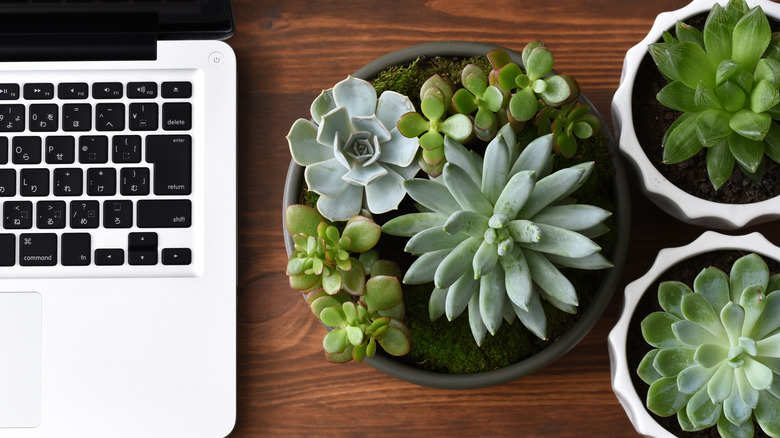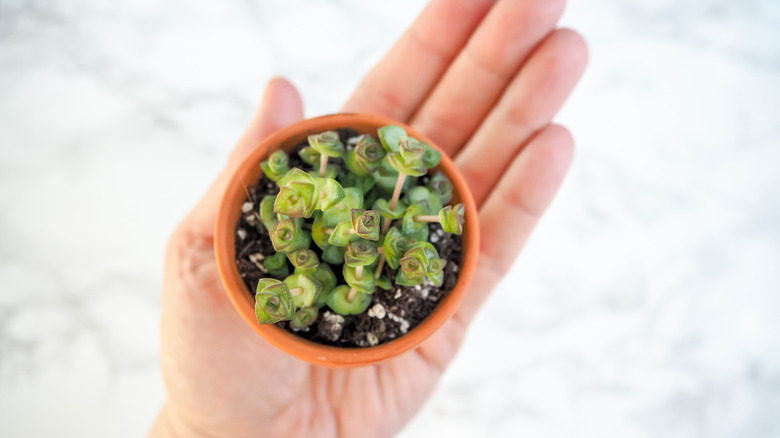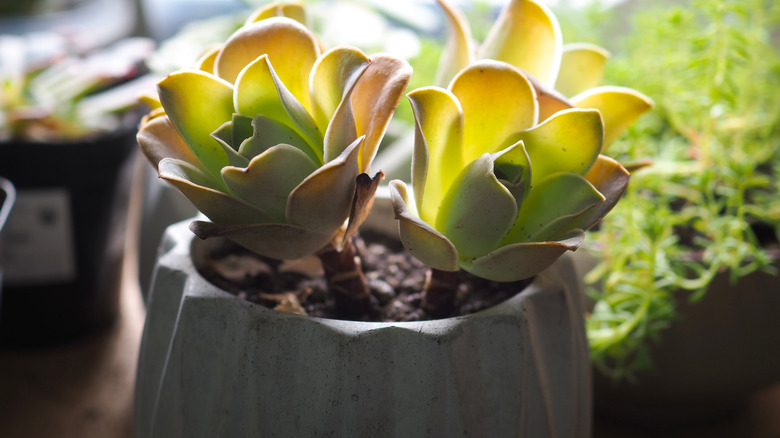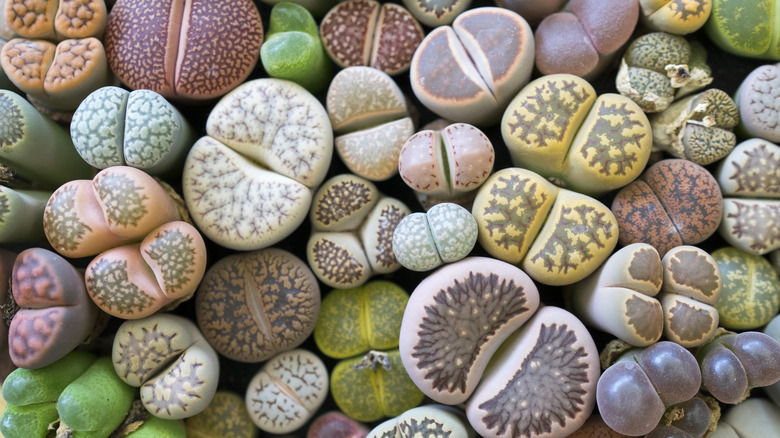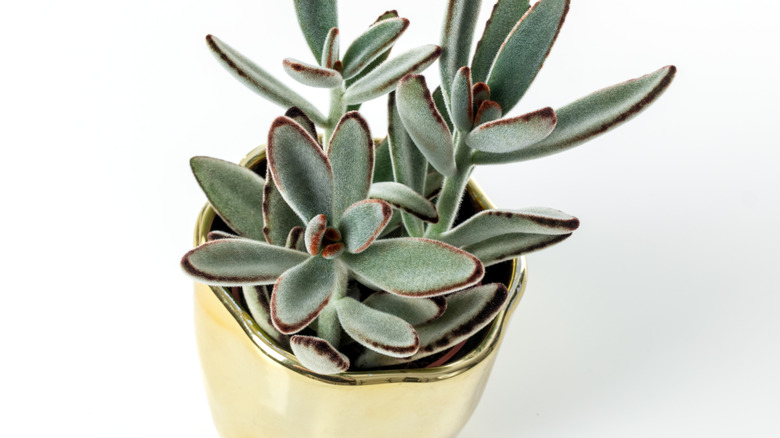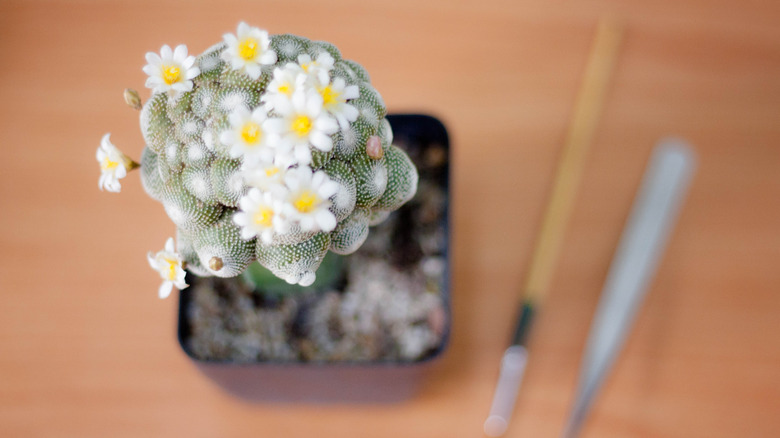Place These Tiny Succulents On Your Desk To Improve Your Health And Focus
Can't concentrate? Join the club. Millennials and Gen Z's are facing accusations of an eight-second attention span, according to SmartUp, the newly diagnosed Pandemic Brain is bringing up issues that mess with our focus, plus it seems like we are all sleeping worse than ever. The barrage of "can't concentrate" complaints has some of us tied in knots — first because of the symptom itself, second because the solutions are confusing and can bring a whole new set of symptoms. It is a lot to drill down on and find our way through to clarity with any sense of, well, focus.
One small idea you might consider at no risk and the possible major payoff is mini succulents. This idea is literally small, as tiny as a few inches depending on variety, yet these mini plants are mental focus mighty. Keeping one at your school or work desk has been said to increase memory retention by as much as 20%, according to a University of Michigan study reported by Red. An Agricultural University of Norway study suggests a whopping 60% diminished sickness rate and Kansas State University research showed less fatigue thanks to plants in your office, room, or on your desk. NASA says they also purify toxins from the air. Keep reading to find out how to have your own mini mental wellness plant in a pot.
Baby jade plant
This mini succulent (scientific name: crassula ovate 'Minima') can grow up to 30 inches but trimmed; it will be a sweet small concentration caretaker at the corner of your desk, not to mention a legendary sign of good luck. Plant your baby jade in a small pot with drain holes on the bottom and ensure the pot also comes with a little drain tray. Use well-draining soil such as soil modified with added perlite or volcanic pumice.
Baby jades do like the sun, so set your little succulent on that corner of your desk that catches rays throughout portions of the day. According to Succulent Thrive, your baby jade will showcase red etching around its bright green leaves if you nourish it with enough sun and not too much watering. To keep it small, once every week or so, clip larger leaves and snip off buds or tips of new branches growing at the base of the plant, says SFGate. Water it only when the soil is dry all the way down to the roots, says Gardener Report, and then douse it thoroughly, mimicking a desert rain of drought, then drench. You will know you are watering too little if your leaves look wilted or browning, too much if your leaves turn yellow.
Mountain rose succulent
This charming rose lookalike (scientific name: Aeonium dodrantale) was originally classified Greenovia dodrentalis. According to Martha Stewart, they were reclassified in 2003. They grow up to 6 inches tall, says House Beautiful, and "bloom" their curved petal and compact rosette-looking cluster all year round. Plant your mountain rose in a pot with drainage holes and a water drainage tray. Be sure to empty the tray of standing water to avoid root rot, says Sublime Succulents. When planting your mountain rose succulent, use a succulent or cactus soil mix that avoids any bits of peat moss or water-retaining materials.
Although the mountain rose plant is a succulent and does not need as much watering as average house plants, its roots are a little more fragile to drying out than other drought-resistant succulents, says Dave's Garden. Water your mountain rose regularly when its topsoil goes dry, rather than soaking them like other succulents. Also, unlike other succulents, the mountain rose goes dormant in summer, so water it less then. These succulents do best in bright, though indirect, sun, which can damage their leaves, so keep them on your desk without the worry of needing direct sunlight. Additionally, your mountain rose succulent will sprout its own sub-sprouts (pups), says Living Succulents, that you can cut and pass around to colleagues who might like to replant and enjoy for themselves.
Living stone succulent
It would be hard to have a list of mini succulents without including this quirky little shaped plant that looks wildly similar to actual rocks. Living stone succulents (scientific name: Lithops) come from the family Aizoaceae and have evolved to match their rocky origin, says Savvy Gardening. They sprout a set of leaves that do not look at all leafy but rather like a spongy pad cracked down the middle where a sole bloom pops out every fall. The flower smells pretty, looks like a daisy, and — also like a daisy — the bloom closes up overnight.
These particular succulents will not be satisfied with a shaft of sunlight that crosses your desk every day unless that stays directly sunlit for five to six hours. Tucking these succulents on a well-lit windowsill may be the answer to their sun needs, but rotate their pot a quarter turn once or twice a week, so all sides get sun. The plant grows from a stem under the soil and has long roots, so consider a small pot that also has a little depth, says The Spruce. Aside from their persnickety sun needs, these plants are as easy-going as can be. They are not prone to disease or pests. Just water them when they have gone completely dry, but even less in winter during their dormancy season. Not surprisingly, living stones need easy-draining soil that has perlite or pumice.
Panda plant succulent
Not every office desk gets to capture even a ray of sunshine across its path, so for those managing in office situations without much natural light, the panda plant (scientific name: kalanchoe tomentosa) is the succulent to consider. The panda plant looks soft and sweet, with leaves like velvet thanks to being covered in tiny little baby soft hairs. Although this plant does like sun, it can get by in low light and shade and still thrive, says Savvy Gardening. If you want to enjoy the panda plant but worry you get too much sun, take care it is a few feet away from any window and preferably one that is a south-facing window, says Epic Gardening. Wide Open Eats warns that direct sunlight can damage the panda plant's velvety leaves. The panda plant's water-holding leaves get a little red edging, says House Beautiful, which is a great color accent to otherwise boring desks.
Like most succulents, your panda plant will need easy draining soil and a pot with drainage holes and a catching tray, says Succulent Thrive. Water your panda plant less often in its dormant winter season and only sparingly in other months when its soil has gone completely dry. Also, you will want to keep these succulents away from pets since they have a toxic sap and also "bufadienolides cardiac glycosides" that are dangerous for animals.
Blossfeldia liliputana
Last but not least is the littlest mini succulent of all – the blossfeldia liliputana (scientific name: blossfeldia liliputana or liliputiana). It measures a mere half an inch in diameter with white or pink flowers that sprout up to a little more than half an inch long and less than half an inch in bloom diameter, says World of Succulents. It is named for the Liliputians from the 1726 fictional story Gulliver's Travels, who measured 6 inches tall.
If your office is a shady place with good airflow, you have met the blossfeldia liliputana conditions perfectly, according to Unusual Seeds. Blossfeldia liliputana needs watering from March until early fall, but only when its soil is very dry since this succulent's roots have a particular sensitivity to humidity. Its blooms will pop out in the spring or early summer but in a slow, deliberate, step-by-step arrival. Like other succulents, blossfeldia liliputana should be planted in fast-draining soil, says Giromagi Cactus and Succulents.
Try any of these succulents for their beauty but also for their concentration caretaking brawn. With research like Exeter University lauding improved productivity and well-being — as much as forty-seven percent improvements among staffs observed in their study as reported by bloomscape – why not glean all the stimulation these plants have to offer?
